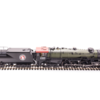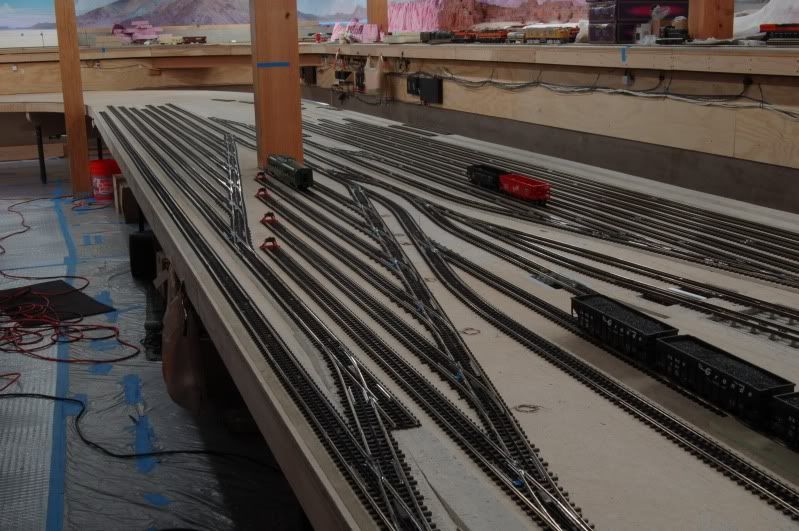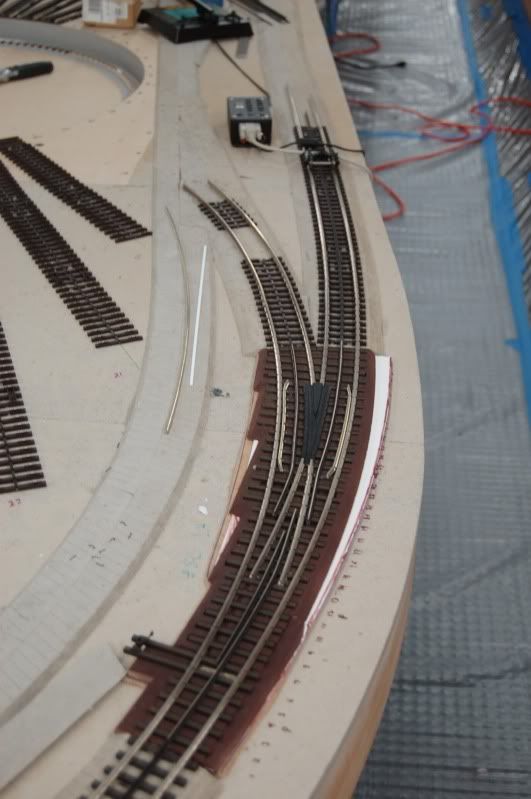As a follow-on to my last post, I notice that in giving my opinion as to the reputation widely enjoyed by Ross Custom, I should have included at least one other. That would be the 0-72 switches made by Lionel. [And of course there may be others.] Granted they may have other problems related to their Chinese reissue. But let's consider the tracking through the Lionel 0-72 switch.
To a large extent, any analysis of the tracking through a switch boils down to whether a wheel flange will climb the switch frog when approaching it from its pointed end. It is true that a flange picking a switch point is also a common problem in the model [the Chinese Lionel 0-72 had this problem, easily if inconveniently cured*].
Interestingly, the prototype had this problem. It was not so much in switches, where there is only one frog, but in unswitched crossings. Sometime in postwar, the AREA investigated this problem, and published a very mathematical analysis of the flange forces against the frog rail. Somewhere around 11 degrees the force was calculated to be sufficient to cause the flange to climb the side of the crossing frog, with the usually available side friction. This is about a #5 frog. I can no longer remember which side of 11 degrees caused the problem, or over what angle. But crossings sharper than a certain angle are no longer used; two switches with facing points are used instead.
With the Lionel 0-72 switch, the problem was as follows: The scale Hudson (let's say the one with the high-rail flanges used today-- there having been at least 3 designs of this switch for various Hudsons: the scale; the semi-scale; and the 1954 tinplate, flange-wise) which last one, with deep flanges used a 1.10" back-to-back of driving wheels. Earlier postwar engines like the Berkshire and the Turbine, with four driving axles, still had about the same wheelbase as the scale Hudson, with only three driving axles. So these engines operated through the predecessor of our current 0-72 switch more or less in the same manner.
On the sharp tinplate 0-72 curve (relative the 48-, 60-, and 72-inch radii of the NMRA O-scale, the deep (and thus fairly thick) tinplate flanges would go through the gap between frog guard rail and stock rail (on the curved path) at an angle. The leading edge of the deep flange pressed against the gauge side of the guard rail opposite the frog. The trailing edge of the same flange pressed against the stock rail itself. In effect, the flange traversed the flangeway at an angle. The result was that the flangeway had to be made rather wider than the prototype.
I also had the impression that the Lionel 0-72 switch had a slight amount of gauge-widening in curve, that reached a maximum at the frog. At one time I thought the frog might have been moved slightly outward from the theoretical curve (possibly to match the outward movement of the active face of the guard rail, at least in part).
A problem to be dealt with was the diesel trucks of the F3 diesel engines, postwar. (Actually this would have first occurred with the motor trucks of the M10000 streamliner trucks, contemporary with the first full-size Hudsons, pre-war.) These short wheel base, small wheel trucks tended to run snugly against the working face of the guard rail, and therefore against a thicker area of their own deep flanges. That is, the wheel conditions against the 0-72 frog were apparently different with the F3's, and particularly with the later MPC reruns of the lighter F3 dummy A's when leading in the pushed position, leading to a tendency to derail by climbing over the frog.
I believe that that MPC made a production error in gauging their F3 wheels at 1.10" back-to-back. IMO, this could have arisen from the fact that the popular Greenberg reproduction of late 40's--early 50's Lionel service station drawings showed only one back-to-back of wheels dimension. That was on the 6220 diesel switcher, and it was 1.10" (remember the wider gauge of 0-27 track?). It was suggested that the service tech make a gage to this dimension. By contrast, if the F3 wheels are gauged by pressing them nearly against the bosses of the bearings in their trucks, the back-to-back of wheels will be 1.07". Clearly this will greatly reduce the tendency to climb the frogs of 0-gauge switches.
I remember the tendency of the Alco FA diesels to climb the frogs of the automatic 0-27 switches was a substantial problem after the introduction of the true split switch with the moving points, leaving the closed frog behind. I had one pair of the automatic 0-27 switches in each of the model years 1951, 1952, and 1953, three pair total. Each pair had a different design in the frog area, but none cured the problem. Since I maxed my layout length using a reversing loop at each end of single track, with an auto passing siding, I took a lot of interest in this.
I have often wondered if the locomotives Lionel made with the 0-27 numbers had a different gauge of wheels than those with the O-gauge numbers, or if the switcher 6220 was the only example of this. Each York I intend to take my calipers, but forget in the rush.
Anyway, I think there may be some question of what the proper back-to-back of various wheelsets should be, among the several modern era makers of engines. This is doubtless something that the Ross company was hoping to which the special forum might have led. I'm surprised at their success in the face of so many problems.
Again the NMRA solution to this problem is to make standards with narrower wheel treads, somewhat smaller flanges, the same back-to-back for all wheelsets, and more realistically narrow guard rail gaps. All of this would wreak havoc with backwards compatibility, and can only be achieved by pushing tinplate toward genuine T-rail, larger radii on curves, and sprung driving axles (and thus jointed main rods on steamers).
Of these, I can only see T-rail and equalized 4-wheel trucks having any chance... the first we have, and the second we had back in the 60's when people built cars from kits (even with Lionel couplers using the Scout conversion coupler). But the rest don't stand any practical chance in the small mass market in O. So again, NMRA standards for 3-rail tinplate, IIRC, are just not useful.
The coming of the big scale four driving-axle models to 3-rail tinplate presented problems beyond even that of the prototype, and of course in Lionel the Corporation never had such models. So it is likely that the Lionel 0-72 switch could not handle these too well. I have not investigated this by trial, nor do I know the situation with other manufacturers. But I can discuss the nature of the problem, later, and maybe able to test one on a Ross switch. I have avoided such engines.
--Frank
![]() but, always good to present new ideas for growth of the hobby!
but, always good to present new ideas for growth of the hobby!









